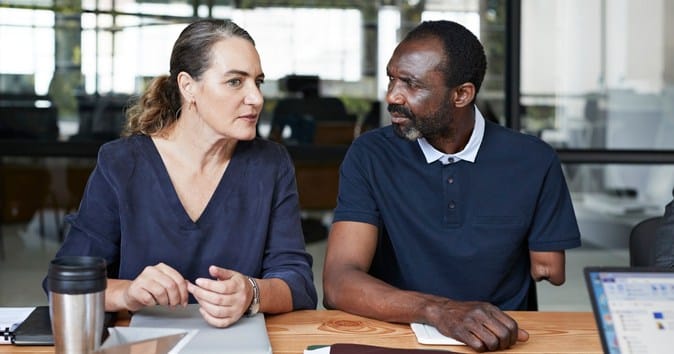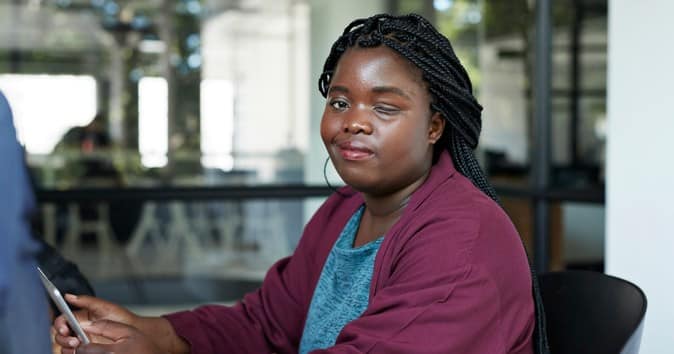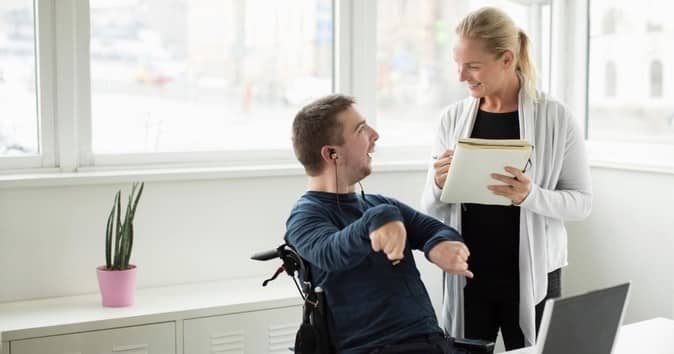Are You Using Ableist Language? Use These Alternatives for a More Inclusive Workplace

You may be surprised to find that many of the common phrases and idioms we use or hear in the workplace and in our day-to-day lives refer to physical or intellectual disabilities. These misused phrases can have harmful, far-reaching effects for communities of people with disabilities.
Some of these terms are so pervasive that it’s easy to think, “well, I didn’t mean it like that.” However, it’s important to think about the impact our language can have on those around us and actively choose inclusive alternatives to language that can be exclusionary and harmful.
In the second post in our Inclusive Language in the Workplace series, we go over what you need to know about avoiding ableist language and how to integrate more inclusive language into your organization.
What is ableist language?
Ableist words and phrases refers to language that devalues people with disabilities. Ableist language sends the message that there is something “wrong” with people with disabilities or that people without disabilities somehow have more value.
When we use these words we are contributing to ableism in workplace, or “the intentional or unintentional discrimination or oppression of individuals with disabilities” as defined by the National Conference for Community and JusticeOpens in a new tab. Disabilities can include physical disabilities, neurological conditions, and mental health conditions.
When many people hear the term ableism or the language around it, they often think of slurs that are purposely hurled as insults. But ableist language is not always so explicit.

Why is ableist language harmful?
Ableist language often equates disability with undesirable characteristics and qualities. For example, the phrase “fall on deaf ears” refers to people ignoring information being shared with them. It does not refer to literal deafness or hearing loss, but it paints deafness in a negative light and equates it to ignorance.
Ableist language can also perpetuate negative stereotypes about disability. For example, saying “I’m so OCD” when you really mean you just like organization perpetuates the idea that people with OCD are simply picky or meticulous when in reality it is a genuine condition involving uncontrollable thoughts, and it can often be debilitating.
The World Health OrganizationOpens in a new tab estimates that 1.3 billion people – or about 1 in 6 people – experience significant disability, meaning a large portion of the population is harmed when we use ableist words and phrases.
People-first vs identity-first language
You may have heard the term “people-first language” before, which recognizes the person before their disability or condition. Two examples of this are referring to someone as a “person with autism” rather than “autistic person,” or a “person with deafness” rather than “deaf person.”
However, there are many who prefer identity-first, such as being called a “disabled person,” rather than “person with a disability.” This may emphasize disability pride or it could simply be a personal preference.
Disability Rights UKOpens in a new tab identifies another reason some people prefer identity-first language, referred to as the Social Model of Disability:
“The Social Model of Disability states that people have impairments, they do not have disabilities. According to the social model of disability, the term ‘people with disabilities’ is said to confuse impairment and disability and implies disability is something caused by the individual, rather than society.
“A Disability is caused by society’s unwillingness to meet the needs of people with impairments. As a result, the term ‘Disabled people’ is used to describe people with impairments who are disabled by barriers constructed by society.”
With all of these options it’s important to listen, give people the space to self-identify, and be open to conversations about how people identify themselves.
If still unsure, AP’s guidelinesOpens in a new tab as of 2021 suggest, ”In describing groups of people, or when individual preferences can’t be determined, use person-first language."

Ableist words and phrases (and what to say instead)
Coming to terms with the fact that many common phrases we use may be unintentionally offensive can be daunting, which is why it’s important to equip yourself and your employees with the knowledge to choose words respectfully and intentionally.
Here are five examples of ableist language to avoid as well as more inclusive words and phrases to replace them:
1. Deaf
Examples: “Fell on deaf ears.”; “Are you deaf?!”
The word “deaf” is often used to refer to ignorance or a voluntary decision to not listen, which is certainly not the case for deaf individuals. Instead of saying something “fell on deaf ears,” say it was ignored.
People who are deaf or hard of hearing are perfectly capable of taking in information and following directions when that information is accessible to them.
2. Lame/Dumb
Examples: “That company outing was lame.” ; “You’re acting lame.”
Historically, “lame” was used to refer to people with weak limbs, while “dumb” was used to refer to people who did not communicate through spoken word. Today, use of the word “lame” has come to mean boring, inferior, or undesirable, while “dumb” is used to demean someone’s intelligence, both of which can be disparaging towards people with mobility disabilities or various other forms of disability.
Before making any type of judgment about someone – using ableist language or not – consider whether it’s actually necessary. If you still think it is, try using words such as dull, bland, or uncool.
3. OCD
Example: “I am so OCD about my desk organization.”
OCD, or Obsessive Compulsive Disorder, involves excessive thoughts and/or repetitive behaviors. It is a mental illness and is not synonymous with simply liking things to be organized or done in a specific way. Using OCD as an adjective when you simply mean “organized” or “meticulous” trivializes the experience of people living with OCD.
4. ADHD
Example: “I’m so ADHD right now, I just can’t focus.”
ADHD, or Attention Deficit Hyperactive Disorder (previously referred to as ADD), is a neurodevelopmental disorder that can lead to inattentiveness, hyperactivity, and impulsiveness. Don’t say “I’m so ADHD” if you simply mean “I’m unfocused” or “I have a lot of energy right now.” Using ADHD outside of its actual definition reduces the experiences of people with ADHD to a stereotype.
5. Crazy/Insane
Example: “This assignment is making me go insane.”
These words have historically been used to discredit neurodivergent individuals or people with mental health conditions, and are often still used to discredit people’s experiences. Instead of relying on disparaging terms, use words such as “outrageous” or “bizarre” instead.
Looking at all of these examples makes it clear that many of the words and phrases we use imply that having a disability is “bad” and/or means a person is somehow lacking. Even if the words aren’t being used as ableist slurs or insults, using them also trivializes the experiences of people with disabilities, neurodivergence, and mental health disorders.
Being conscious of the language we use is the first step in building toward an inclusive culture.

How employees can help build an inclusive workplace
Across all industries and in every organization there are countless ways to reduce unconscious bias and build a more inclusive workplace for disabled employees. And while it will take sustained action from organizations to build this culture, there are many things we can do to get the process started.
Here are three ideas for employees to consider implementing when creating a more inclusive environment.
1. Be respectful and listen
Avoiding ableist language does not mean avoiding talking about disabilities. Learning about non-ableist language actually does quite the opposite; understanding the background and everyday experiences of those with a disability helps us to create an inclusive culture and informed employees.
When talking to a person with disabilities or about the disabled community in general, keep these things in mind:
- Pay attention to the language people use to refer to themselves and follow their lead on people-first vs identity-first language. If you listen closely, you may not even need to ask!
- If a person has disclosed that they have a disability, ask them what language they would like you to use to refer to their disability.
- Be mindful of the context and environment you’re bringing up the question; what a person feels comfortable talking about in one setting may differ from what they want to discuss openly at work

2. Accept and act on feedback
We all make mistakes sometimes. And one of the most important factors of a safe workplace is that employees feel comfortable making a mistake without the threat of negative consequences.
In order to ensure everyone feels safe in the workplace, mistakes should be acknowledged and sincere apologies made, emphasizing what will be done (or not done) in the future. Using ableist language – in the workplace and beyond – is one of those mistakes. Everyone slips up sometimes, and that’s okay, but in order to be an ally to people with disabilities, we must take whatever feedback is given and implement it going forward.
Accidentally using an ableist phrase once is a mistake. Not learning from that mistake, however, is a choice.
3. Be curious and engage with resources
Make a conscious effort to learn and understand the history and wide range of lived experiences within the disability community to show your respect and support. We can educate ourselves by reading, watching, and engaging with content created by those who experience disability.
Here are a few resources to take a look into:
- The National Disability Navigator Resource CollaborativeOpens in a new tab has created a guide to assist individuals with disabilities to make informed decisions about their healthcare, but it can also be used by anyone to gain information about the barriers these communities face.
- This TED talkOpens in a new tab by disability activist Valerie Kosson about invisible disabilities and the challenges she faces with her specific disability
- The Disability Visibility podcast Opens in a new tabis hosted by Alice Wong and is about “life from a disabled lens,” and touches on topics intersecting with the disabled community like healthcare access, climate change, mental health, and social justice.
- Haben: The Deafblind Woman who Conquered Harvard LawOpens in a new tab is a powerful memoir that follows the first deafblind graduate of Harvard Law School on her mission to achieve equal opportunity for all.
There are also many pieces of fictional work that are written by people with a disability to shed light on their experiences in a less academic way. These books, while not based on any one true story, are filled with anecdotes and lessons to be learned.
Check out:
- One, Two, Three Opens in a new tabby Laurie Frankel is a story of triplets, two of whom were born with a disability.
- Out of My MindOpens in a new tab by Sharon M. Draper is a novel about a young girl with cerebral palsy, the most common motor disability among children.
Whichever resources you choose, make sure you are going into it open to different viewpoints and recognizing the diversity inherent in the disability community.

How organizations and HR professionals can build a more inclusive culture
Employees can only do so much without the support of their employers. Here are 3 things companies can do to create a better workplace for all employees.
1. Ensure greater accessibility
Accessibility should be considered in every aspect of workplace planning. From the content your company puts out to the spaces you plan your annual conference, make sure all employees are able to access resources and places. There are more examples than we have time for, but keep these things in mind:
Content
- Alt text for imagery
- Transcriptions available for videos and audio
- Closed captioning for videos
- Use of color and contrast
- Timing, animation, and flashing content
- Reading level, abbreviations, and jargon
Office/Event space
- Elevators and ramps
- Floorplan with enough space for wheelchair use
- Utilize indoor maps
- Accessible parking
- Option for remote work when possible
Technology
- Screen readers
- Braille displays
- Screen magnifiers
- Speak to text software
- Including hearing aids and mental health coverage into medical insurance plans
- Purchasing/procuring WCAG compliant Opens in a new tabsoftware
And with the European Union’s passing of the European Accessibility AcOpens in a new tabt, requiring certain everyday products and services to be accessible for people with disabilities, these accommodations are only going to become more common and necessary.
2. Assess recruiting and hiring practices
Ableist attitudes can very easily find their way into recruiting strategies, and an audit of the companies job descriptions is one of the first steps in effectively addressing the problem. When looking at how your company presents new jobs to candidates, ask these questions:
- Where is your company posting job opportunities?
- Could the language used in job postings be discouraging candidates with disabilities from applying?
- Clearly indicate which job requirements are essential and which are “nice-to-haves.”
- Describe the work environment and work culture so that candidates can make an informed decision about whether the job is a good fit.
- Include information about the potential for remote or hybrid work, flexible hours, and PTO benefits
- Review any physical requirements included in job descriptions and remove or edit these requirements if they aren’t actually required. For example, is it necessary/reasonable to require that an accountant “must be able to lift 50 lbs?”
Next, look at the interview process. Are you following best practices?
These include:
- Sending out a pre-interview questionnaire asking candidates if they need any accommodations
- Being flexible with interview format (in-person or remotely) and length of interview time
- Providing accessibility resources to potential employees before they accept an offer so they can ensure they will have the support they need
Giving employees the option to work hybrid or remotely has also been extremely helpful in broadening the opportunities available to those with disabilities. In fact, Meta began offering fully remote positionsOpens in a new tab during the pandemic and found “candidates who accepted job offers for remote positions were ‘substantially more likely’ to come from diverse communities: people with disabilities, Black, Hispanic, Alaskan Native, Native American, veterans, and women.”
This isn’t limited to Meta; the rise in remote work has led to the highest rate of disabled workers since record high rates in 2008.
3. Implement Inclusion Advisor
Employees feel best when they are valued and appreciated, and an employee recognition tool makes that possible. While recognition is more powerful when it comes from a peer, it can lead to recognition messages that contain ableist words that may unintentionally harm the recipient.
Inclusion Advisor is an AI-powered, in-the-moment DE&I coaching tool that empowers employees to make communication meaningful and inclusive for all. As an add-on to Workhuman’s Social Recognition platform, Inclusion Advisor gives users the chance to check recognition messages for bias.
If bias is detected, users are shown actionable advice for removing biased language and crafting a more inclusive message. The tool gives users the opportunity to learn more about ableist language and inclusive alternatives to ableist phrases while also encouraging them to stop and think about the impact of their language. And more than half of the time, they choose to change that language.
There's no room for bias in the workplace. Luckily, Inclusion Advisor helps to identify and mitigate ableist language, shifting the culture of your organization one recognition message at a time.
With good intentions and determination, we can work to build a better world – and better work life – for people with disabilities. And we can start doing that within our own organizations today.
About the author
Natural Language Processing Team
Caroline Kaine and Cassie Newland are members of Workhuman's NLP team and are the creators of our Inclusive Language in the Workplace Series.